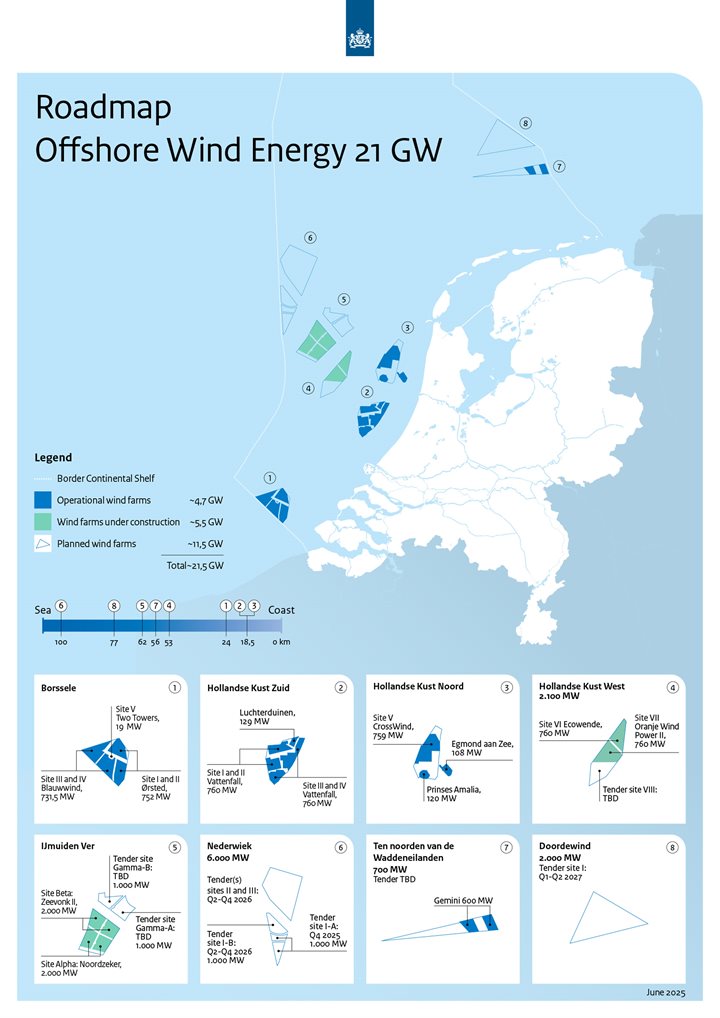Energy transition in the North Sea
Climate goals and energy needs
To achieve the aims of the Climate Agreement from late 2015, the Netherlands originally proposed production of 49 terawatt hours (TWh) of offshore wind energy per year by 2030. That would require a capacity of 11.5 gigawatts. In 2022, the cabinet decided to increase the target to approx. 21 gigawatts in 2030 (later adjusted to 2032/2033). The Roadmap and the Additional Roadmap 21 gigawatt for Offshore Wind Energy 2030 sketch an outline for the development of the new wind farm zones required for that.

The production of electricity on an offshore wind farm involves much lower (about a factor of forty) greenhouse gas emissions than production of electricity in a Dutch natural gas-powered plant. And even lower (about a factor of eighty) than electricity production in a Dutch coal-powered plant. Greenhouse gas emissions that are created during the production, transportation, maintenance and decommissioning of a wind turbine are only a fraction of the amount of greenhouse gas that that wind turbine saves relative to fossil fuel use during its service life.
So offshore wind farms generate plenty renewable energy, which is badly needed. The energy is converted into electricity and transported to shore. This is important for the electricity supply and heating of our households, but also for industry. Industry needs renewable energy if it is going to replace current fossil fuels and resources with energy from more sustainable sources and 'green molecules', such as hydrogen from the electrolysis of water. Electricity from wind farms can, in turn, be used for the electrolysis in that case.
As a result, the North Sea wind farms can make a contribution to the climate targets that we in the Netherlands stand for. This is why there are also plans to develop new wind farms after 2032.
Energy Accord
Agreement was reached in the 2013 Energy Accord for sustainable growth, stating that by 2023 offshore wind farms would have a total capacity of around 4.5 GW. Subsequently, in 2015, the Dutch Offshore Wind Energy Act came into effect. This Act allows the government to allocate sites for the development of offshore wind farms.
The first road map for offshore wind farms (up to 2023) was used to allocate sites in the Borssele and Hollandse Kust (South and North) wind farm zones.
Roadmap 2030
The 2030 roadmap sketches the outlines for creating extra capacity of around 7 GW of offshore wind energy in the 2024-2030 period. The majority of this (over 6 GW) has to be generated in zones that had already been allocated in the National Water Plan 2016-2021. These are the Hollandse Kust (west), Ten noorden van de Waddeneilanden and IJmuiden Ver zones.
For more information on the Roadmap for Offshore Wind Energy 2030 see the letter of 27 March 2018 from the Minister of Economic Affairs and Climate to the Lower House of Parliament and the official announcement.
Additional Roadmap 2030
In 2020, encouraged not least by the Netherlands, both the European Commission and the European Parliament stated the aim of reaching a reduction in CO2 emissions of 55 per cent by 2030 compared with 1990. It was considered that offshore wind energy would have an important role to play in that regard. For that reason the cabinet decided, in early 2022, to create a total capacity of approx. 21 GW of offshore wind energy by 2030 (adjusted later to 2033). That is to say, an extra capacity of 9.5 on top of the previously stated ambition of 11.5 GW.
The Climate Agreement had already stipulated that a possible additional challenge for offshore wind energy in the period up to and including 2030 would be contingent on two important conditions:
- There is a demonstrable demand for energy from heavy industry near the coastline. Where energy demand is high it is not necessary to transport the energy further inland or to expand the high voltage network, which that would entail.
- Sufficient new wind farm zones have been designated
For more information see the letter from Minister Jetten of 10 June 2022 Additional Roadmap 2030 (Roadmap 21 gigawatts).
Download the Roadmap as pdf. (pdf, 795 kB)
Offshore grid and VAWOZ 2030
Network operator TenneT is responsible for connecting the new offshore wind farms to the national high voltage network and for distribution of the electricity generated by wind.
In late 2021 the Minister of Economic Affairs and Climate announced the results of the Investigation of cable landing points for offshore wind energy for the period up to and including 2030 (VAWOZ 2030). The objective of this investigation is to identify possibilities to bring more wind energy from sea to land in this period, an acceleration that is needed to achieve the climate goals for 2030.
New wind farm zones
In the unused offshore wind farm zones (or parts thereof) referred to in the National Water Plan 2016-2021 there was little space left for new wind farms. So, in March 2022, the cabinet designated the wind farm zones Nederwiek, Lagelander and Doordewind that will make it possible to hit the target of approx. 21 GW of offshore wind energy by around 2030 (ajusted later to 2033). These new wind farm zones have been designated in the North Sea Programme 2022-2027.